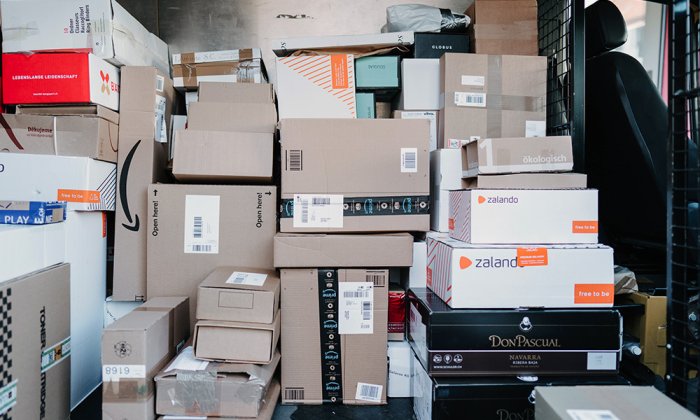How Amazon Branded Convenience and Normalized Monopoly

Amazon is omnipresent in our daily lives — we stream movies and television on Amazon Prime Video, converse with Alexa, and receive messages on our smartphone about the progress of our latest orders. In her book “Buy Now,” Emily West, a communication professor at UMass Amherst, examines Amazon’s consumer-facing services to investigate how the brand grew so quickly and attained a level of ubiquity in our lives while hiding in plain sight. Amazon, West argues, is very big in multiple respects, but prefers that we don’t notice.
A goal of West’s book, which is freely available for download, is to inform Amazon users about the company’s strategies for market dominance and offer ideas for how, as consumers, we might better understand the nature of a platform giant like Amazon and resist its power. “Buy Now” is motivated, she says, by the belief that we need to confront the costs of convenience, and reclaim our consumer power, rather than let ourselves be served to distraction.
The Editors: I was surprised to learn that Amazon is consistently ranked as one of the most trusted brands in the U.S. How do you explain that?

Emily West: Yes, the quality of the relationship that Amazon has cultivated with its customers is perhaps what interests me the most, and is a major focus of “Buy Now.” Amazon is not just one of the most trusted but one of the most loved brands in the U.S., which is surprising because it’s not a brand that necessarily pops to mind when we think of the brands that people love. We’re more likely to think of brands with strong lifestyle identities and a lot of strong iconography and storytelling in their marketing: brands like Nike, Disney, and Harley Davidson.
While the company does advertise particular products and services (like Echo smart speakers, Alexa, and Ring cameras), it has long focused on “customer obsession” and at times has favored investing in the quality of its services over its advertising budgets. Amazon has built up trust and deepened its relationship with customers by encouraging them to have more frequent, and more types, of interactions with it over time, and has focused on making those interactions predictable, easy, fast, and personalized. While 20 years ago an Amazon customer might have interacted with the company a few times a year, when buying books or CDs, today they might visit the site multiple times a day to look at products, or spend extended periods interacting with Alexa or consuming Amazon streaming services, allowing it to become a familiar presence in their home and life.
The Editors: You write in the book that while Amazon may still seem like a straightforward online retailer to many of us, the company is in fact coming to define the digital economy and has more information about us than we probably realize. Yet most pushback has come from within the company — the average consumer doesn’t seem to care or fully understand what Amazon is doing with that data. Is that perception changing? And can you briefly explain some of the ways our data is collected and used?
Emily West: I’m not sure that it’s the case that people don’t care or are unaware that digital companies, especially tech giants like Amazon, are collecting tremendous amounts of personal information about us. Rather, I think people are resigned about these forms of intensive dataveillance, seeing it as an inevitable state of affairs that is becoming increasingly difficult to change or resist. I believe that Amazon encourages this feeling of resignation and elicits user consent to ever more invasive forms of personal surveillance by promoting and packaging surveillance as essential to its personalized, convenient services like Alexa, in-home or in-car delivery (a service called Amazon Key), personalized recommendations, and lifestyle optimization from personal monitoring.
Related to the idea of the trust and even affection that people feel for Amazon, the way that the brand — particularly personified as Alexa — explicitly offers to closely observe and truly know the user in order to provide more personalized, convenient service, builds a sense of care and even intimacy between consumer and brand. Amazon is the tech giant in the living room, a state of affairs that has rapidly been normalized in the United States at least.
Amazon is the tech giant in the living room, a state of affairs that has rapidly been normalized.
While most users are pretty aware and likely resigned to the fact that a company like Amazon knows a great deal about them, I think it’s also true that the average user doesn’t have a very clear sense of how Amazon uses all this data, and what the implications of a tech giant like Amazon knowing so much about us are. There’s a general sense that Amazon “sells our data,” but in fact Amazon is extremely proprietary about user data. It does sell a whole variety of target marketing services (to both third-party Amazon marketplace sellers but also many other advertisers who want to reach Amazon customers) and is doing this with such success that in a relatively short period of time it is starting to catch up to Google and Facebook’s duopoly in the digital advertising market. Amazon’s strength in digital advertising is likely to only grow, since it has so much unique market intelligence about the products that people buy and search for, and can relate these data to more and more other things about us, including our domestic habits and behaviors and our entertainment preferences.
But beyond using our data to become a digital advertising giant, Amazon uses this information to solidify its own market dominance in its current products and services, and to move into new ones. It both is the marketplace and competes in it, and can use the treasure trove of data about us to out-compete third-party sellers on its site, and to steer us to its own products or to more profitable products through its search algorithms and recommendations.
The Editors: Your second chapter focuses on what you call “distribution fetishism,” a branding technique that creates a personalized, affective relationship between consumer and brand, while discouraging attention to the labor and the digital technology and its environmental impacts behind the scenes. In what ways has Amazon used this technique?
Emily West: Amazon focuses the attention of the end user on time to delivery rather than how a product is traveling across space in a way that requires a great deal of intensive labor and infrastructure. The concept of “distribution fetishism” is my re-working of Marx’s concept of “commodity fetishism,” in which he argued that we misperceive the value, or price of a commodity as being inherent or natural to it, rather than as a function of its raw materials and the labor-time it took to extract them and then produce it. Amazon’s primary business is delivering goods to us, and until recently, people thought very little about the supply chain and warehouse work that it takes to get us goods in ever faster delivery times. Amazon encourages this lack of thought to the actual delivery process in a variety of ways, with the information that it chooses to share (when your item ships, when to expect it, how many “stops away” it is when it’s out for delivery, a notice that your item has been delivered), and the information that it doesn’t (where it shipped from, what fulfillment and delivery centers it went through, which company is doing last-mile delivery).
What makes warehouse work so challenging for workers — the long hours, the repetition, the isolation — is not perceivable from spending a minute at a time observing these roles on a tour.
When I started writing “Buy Now” about five years ago, I’d say that distribution fetishism was more firmly in place. But with the pandemic everyone became much more aware of the complexity of supply chains and warehouse workers being “essential workers” who were exposed to dangerous conditions in order to keep the delivery of goods (and not always essential ones!) moving. We couldn’t take the one- and two-day shipping for granted anymore. Even before the pandemic, Amazon responded to critiques and concerns about warehouse employment by offering tours at some of its fulfillment centers to the public. While these tours are a gesture towards countering the distribution fetishism that Amazon has cultivated for many years, I found that they don’t actually substantially undermine it. The tours that I took emphasized the role of computing and information technology in Amazon’s distribution system much more than the role of human labor. What makes warehouse work so challenging for workers — the long hours, the repetition, the isolation — is not perceivable from spending a minute at a time observing these roles on a tour.
The Editors: In a chapter exploring the environmental impacts of ecommerce, you write that online shopping is potentially greener than shopping at stores. Is that true for Amazon?
Emily West: The environmental impact of shopping with Amazon is something that I know weighs on the minds of many Amazon customers. There’s widespread guilt about Amazon boxes piling up on our doorsteps — does this make us look both lazy and unconcerned with the state of the planet? What I found is that, in fact, shopping online can be a greener option compared to shopping in person at a store, but there are a lot of important caveats. If you are walking, biking, or taking public transit to a store, then shopping in person is still likely to be the greener option. But since many of us drive to shops, then home delivery can be greener, mainly because a single truck dropping things off at multiple addresses has a lower carbon impact than cars from each of those houses driving to a store. In addition, the product only spends time in trucks and a warehouse, not a retail store with the associated heating, lighting, and computing. However, the moment that a product needs to be shipped so quickly that it requires an airplane trip or a high-priority truck delivery with no regard for efficient routes, then home delivery may no longer be the greener option.
Fast delivery — one or two days and even faster in some large cities — is central to Amazon’s brand identity and promise. And Amazon does nothing to promote transparency to customers about the carbon implications of choosing faster shipping speeds, when it could very easily do so. For a while now, it’s been nudging users to choose slower shipping speeds, by encouraging consolidated deliveries on a weekly day, or offering credits for digital rentals if you choose a slower delivery date. But it has resisted connecting these choices to the carbon impacts of delivery, when it could no doubt quite easily do so. And since one- and two-day shipping are expensive for Amazon to provide, there would also be a business reason for making this connection.
Yet just in the last couple of years, Amazon has started presenting itself as a leader in corporate climate accountability. It co-founded an organization called The Climate Pledge, in which corporations pledge to achieve “netzero carbon” by 2040 (10 years ahead of the Paris Climate Accord). And it started a “Climate Pledge Friendly” designation for products, a vague designation which means the product qualifies for one of several environmental or ethical product designations created by 3rd parties, or that it’s been deemed by Amazon to have the least carbon impact in its product category. However, this designation is not very prominent or visible on its ecommerce site, at least to date, and it notably focuses on the carbon impacts of products rather than on the impacts of Amazon’s distribution services.
Amazon does nothing to promote transparency to customers about the carbon implications of choosing faster shipping speeds, when it could very easily do so.
Amazon is a huge company with extensive infrastructure for both its cloud and distribution services. It doesn’t have a strong record in transparency on climate issues, doesn’t convincingly promote this issue with its end users, and has a vested interest in customers buying as much as possible as frequently as possible. While Amazon is now positioning itself to be a climate leader, I have reservations about consumers depending on, or taking comfort from, Amazon’s efforts in this area. There is potential to participate in ecommerce in ways that are mindful of its relative carbon impacts, but while Amazon has earned a lot of consumer trust, I’m skeptical that this is an area where that trust is really warranted.
The Editors: Amazon heightened customer satisfaction with its two-day shipping. Now, as you mentioned, it offers one-day shipping — sometimes even an hour. As a result, how are customer expectations impacting small businesses, warehouses, and distributors that simply can’t provide this kind of automatic fulfillment?
Emily West: Yes, shipping speed has been Amazon’s “killer app” so to speak. It has set an industry standard for competitors like Walmart and Target, and made meaningful competition by smaller players and new market entrants much less likely. Customer expectations for Amazon’s shipping speeds and associated delivery services (like easy returns and certain guarantees for products) have made selling on Amazon feel far from optional for many small businesses. Amazon is where a huge proportion of shoppers are searching for and purchasing products — consider that there are an estimated 153 million Prime members in the United States! So while many small sellers would rather avoid selling on Amazon (because Amazon takes such a substantial cut of sales and the costs of marketing on Amazon so people will actually see and buy your product on the site are exorbitant), most feel they cannot avoid it.
In addition, customer expectations for fast and free shipping are arguably making consumers less likely to shop around — ironic, since that is precisely what online shopping is good for. Especially for Prime members, the prospect of slower shipping, or having to pay for shipping on another site, creates a disincentive to look beyond Amazon when shopping online. While we assume that the ability to easily compare prices online would drive prices down, there’s increasing evidence that Amazon’s strategies of platform enclosure have been effective, and that customers are often happy to stay on Amazon’s site, be nudged to a purchase by Amazon’s search algorithm or recommendation or the promise of free and fast shipping with a Prime-eligible product, and never look elsewhere, perhaps where they would have found a better product option or a lower price. This tendency on the part of Prime members in particular to stick with Amazon’s products and services out of ease and convenience is an example of how I argue Amazon is cultivating consumers to be a “served self” in contrast to a “choosing subject,” the latter being a more active, labor-intensive, discerning approach to consumer behavior.
The Editors: Rapid service doesn’t just influence consumers, it has a significant impact on the well-being of the workforce. Efforts to unionize have increased and even been successful, but such progress has been minimal. Why has there been such resistance to unionizing?
Emily West: The Staten Island warehouse successfully unionized just a couple of months ago, and Starbucks and Apple stores started to unionize around the same time, so it may be early days to judge the momentum or lack thereof on these efforts. I think it’s important to put this successful unionization effort as well as several other near misses in context. That context includes a no-holds-barred anti-union effort from Amazon that is incredibly well-resourced, and skirts or has been documented violating laws against union-busting. Bearing that in mind, the successful vote in Staten Island, led by former warehouse worker Chris Smalls, is a huge accomplishment. Given that Amazon is the second-largest private employer in the United States, it is a potentially significant sign of a sea-change in labor relations in this country.
However, the structural conditions in these warehouses do not at all lend themselves to unionization efforts. The turnover in the workforce is incredible, estimated at 150% per year, such that many signed union cards may no longer be relevant at the time of the actual vote, as those employees may be long gone. Further, the work itself is extremely isolating. Most roles in the warehouse are done individually, with moment-to-moment work instructions coming from a computer rather than a person. Breaks are brief, and the warehouse is large, so there’s not as much opportunity to gather and share perspectives as there might be in other kinds of workplaces.
And this doesn’t even consider the long history of decline in unions in the United States. Again, the broader context is really important, particularly when Amazon fulfillment centers are located in communities that have suffered the loss of other kinds of jobs. We’re also in a historical moment when the United States is defined by tremendous inequality in income and opportunity, such that the populations being targeted for these jobs may see themselves as dependent on an employer like Amazon, rather than seeing the ways in which Amazon is actually dependent on them to do this demanding work that is central to its business and brand.
Finally, we shouldn’t discount the ways that Amazon has responded to the bad press and employee dissatisfaction with warehouse work. I don’t know for certain if these efforts have made a difference to potential union activists or supporters, but there’s no doubt that Amazon communicates loud and long about the positives in how it treats its warehouse employees: the $15/hour minimum, the 20-week paid parental leave, health insurance, the training for other high-demand careers and tuition support. I don’t think these employment benefits could ever replace the protection of basic rights and promotion of safe, sustainable workplaces that a union could provide, but they may well soften the demand for a union if some Amazon workers perceive these benefits as evidence of good faith from Amazon. Amazon added “Attempt to be Earth’s Greatest Employer” to its list of leadership principles last year (phrased with a lack of humility that is very on-brand!), so I see this as more evidence that Amazon will be throwing everything at the wall to “get ahead” of these unionization efforts going forward.
The Editors: Lastly, can you talk about a few of the ways we, the average consumers, can confront these often hidden costs of convenience?
Emily West: I wrote this book because I think consumers must be more engaged with the ways that a company like Amazon infiltrates our lives and then uses our delight and convenience as a reason to justify its monopolistic control of markets, its ruthless extraction of productivity from workers, and its poor treatment of many third-party sellers on its platform. Amazon workers, both in the warehouses and its corporate offices, have been the most vocal and impactful in critiquing Amazon’s business practices, but they have the most to lose.
So I think consumers absolutely must be more involved, and have a more direct voice in the conversation about Amazon’s power and whether or how that power should be monitored and perhaps reined in. I think consumers should be more informed about the full extent of Amazon’s business activities, the ways Amazon’s business practices impact the third-party sellers who create so much of the choice and product diversity on the platform, and have more opportunities to contrast how Amazon acts as a business and employer with the everyday experience that the consumer has with Amazon. While many consumers feel dependent on and even cared for by Amazon as a brand, its workers and business partners more typically experience it as a ruthless behemoth.
There’s definitely room for more mindful and ethical consumption from consumers, whether that’s reducing the amount of shopping we do online, diversifying the places we shop from, or finding less carbon-intensive ways to receive our packages. But I remain skeptical that individualized consumer decision-making will have a meaningful effect on Amazon’s fortunes or business practices. When the root causes of Amazon’s power are a combination of its own business practices and the deregulated environment it operates in, I don’t think it’s realistic to suggest that individual consumers can serve as the primary check on Amazon through their day-to-day purchasing decisions.
Individual-level consumer activism must be paired with some kind of collective organizing and demands from consumers for more transparency.
Rather, individual-level consumer activism must be paired with some kind of collective organizing and demands from consumers for more transparency in the logic of how platforms like Amazon work, how they use and profit from our data, and support for regulatory efforts. Currently in Congress there is legislation being considered that would put in place common-sense checks on the power of platforms, including rules against self-preferencing, and more scrutiny of corporate acquisitions. Beyond that, an organized consumer movement might advocate for limits on the degree of market share and integration of products and services that a single company should have. For example, should Amazon be able to dominate both ecommerce and last-mile delivery? Should it be able to dominate both ecommerce and cloud services? At a certain point, a company like Amazon goes beyond being a competitor in a marketplace to a kind of infrastructure that by default sets the rules and standards that others must abide by, and that’s the type of disproportionate corporate power that doesn’t serve us in the long run.
The fact that so many people use, trust, and even love Amazon may have discouraged regulators from scrutinizing its power and business practices for too long, but the tide has started to turn, and consumers can encourage that by communicating that they support reasonable limits on corporate power, even if those corporations produce consumer convenience and delight.
Emily West is Associate Professor of Communication at the University of Massachusetts Amherst and the author of “Buy Now.” An Open Access edition of the book can be freely accessed here.

